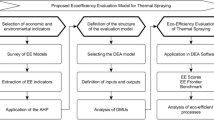Abstract
The resource potential of heavy petroleum residues for obtaining high-quality road asphalt has been estimated using data envelopment analysis (DEA), an effective method for processing large data arrays. The approach used has made it possible to determine the frontier of the resource potential of heavy petroleum residues, that is, to predict the quality of asphalt for any combination of the composition of residual petroleum feedstock and obtain information about the necessity of adjusting the component composition of mixtures for manufacturing the product with desired properties. Using a sample of 99 experiments, it has been shown that the highest efficiency in achieving the normative characteristics of asphalt is achieved by introducing heavy vacuum gas oil and atmospheric residue into a highly viscous vacuum residue. The feasibility has been shown of using effectively deasphalted asphalt and slop as modifying components, the optimum concentrations of which in the vacuum residue are 20 and 40 wt %, respectively.





Similar content being viewed by others
REFERENCES
Yu. E. Pleshivtseva, M. Yu. Derevyanov, D. V. Kashirskikh, et al., Neft. Khoz., No. 8, 104 (2018).
P. M. Tyukilina, V. N. Mel’nikov, V. A. Tyshchenko, et al., Khim. Tekhnol. Topl. Masel, No. 5, 13 (2015).
W. W. Cooper and L. M. Seiford, Data Envelopment Analysis: A Comprehensive Text with Models, Applications, References and DEA-Solver Software (Kluwer Academic, Boston, 2000).
G. Yu. Chernyshova and R. N. Kovalev, Fundam. Issled., No. 8, 453 (2017).
A. N. Lissitsa and T. S. Babicheva, Disc. Pap., No. 50 (2003). http://nbn-resolving.de/urn:nbn:de:gbv:3:2-23263.
E. Behzadfar and S. G. Hatzikiriakos, Fuel, 116, 578 (2014).
P. E. Krasnikov, M. M. Gavrilov, K. A. Efimenko, et al., Pet. Chem. 58, 646 (2018).
A. A. Gureev, Petroleum-Based Binder Materials (Nedra, Moscow, 2018) [in Russian].
Funding
This work was supported in part by the Ministry of Education and Science of the Russian Federation (project part of the state assignment, project no. 10.3260.2017/4.6)
Author information
Authors and Affiliations
Corresponding author
Ethics declarations
The authors declare that there is no conflict of interest requiring disclosure in this paper.
Additional information
Translated by S. Zatonsky
Rights and permissions
About this article
Cite this article
Tyukilina, P.M., Krasnikov, P.E., Derevyanov, M.Y. et al. Assessment of Resource Potential of Heavy Petroleum Residues by Data Envelopment Analysis. Pet. Chem. 59, 1207–1212 (2019). https://doi.org/10.1134/S0965544119110148
Received:
Revised:
Accepted:
Published:
Issue Date:
DOI: https://doi.org/10.1134/S0965544119110148




